Historic Centre of Kraków: Kraków was once the capital city of Poland. The Historic Centre of Kraków is located at the foot of the Wawel Hill. The hill is a limestone outcropping, dominating the historic centre of Kraków. In the 11th century, the Wawel Royal Castle with an armoury and the Wawel Cathedral were built on the Wawel Hill. The cathedral is built in a mixture of styles. The Zygmunt Bell of the Wawel Cathedral is heavier and 350 years older than the Big Ben of Westminster Abbey in London. Polish kings were crowned and buried in the cathedral on the Wawel Hill, even when Warsaw became the capital city of Poland. The Sigismund Chapel and the crypt beneath the Wawel Cathedral holds the tombs of Polish kings, one of the toms in the crypt is built in the Mannerist style, other Mannerist Architecture in Poland can be found in Zamość and Kalwaria Zebrzydowska. The main market square in Kraków, Rynek Glówny, is the largest market square in Europe. The Kraków Cloth Hall is situated in the Rynek Glówny. The Kraków Cloth Hall is the oldest shopping mall in the world. During the 15th century, the Kraków Cloth Hall imported exotic products such as silk, leather, spices and wax, Kraków itself exported salt from the Wieliczka Salt Mine, lead and textiles. The 13th century Basilica of the Virgin Mary is situated in the Rynek Glówny. The Kraków Signal, or Hejnal Mariacki, is played by a trumpeter each hour from the highest tower of the Basilica of the Virgin Mary. The famous astronomer Nicolaus Copernicus studied at the Jagiełłonian University of Kraków, the oldest university of Poland, it houses the masterpiece 'De Revolutionibus Orbium Coelestium' (1520) by Nicolaus Copernicus, this seminal work was inscribed on the UNESCO Memory of the World Register. In 1978, the Historic centre of Kraków, covering the Old Town and the Wawel Hill, was inscribed on the UNESCO World Heritage List as: Cracow's Historic Centre. The name was changed in 2013: Historic Centre of Kraków. Work of Art: Copernicus
www.werelderfgoedfotos.nl © Copyright World Heritage Photos
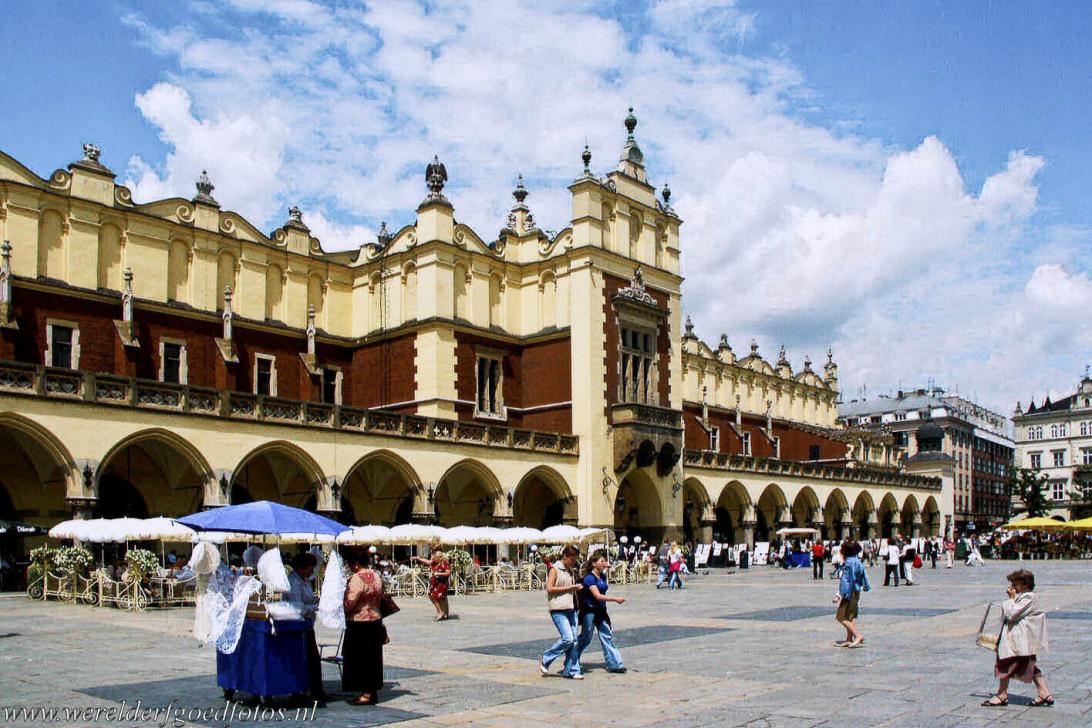
The Kraków Cloth Hall is one of the most iconic buildings of the city. The Cloth Hall is situated in the middle of the Rynek Główny, the main market square in Kraków. The square situated in the heart of the historic city. The Kraków Cloth Hall, Sukiennice, it is the oldest shopping mall in the world. During the 15th century, the Kraków Cloth Hall was the source of exotic imports, such as silk, leather and spices, Kraków exported textiles, salt from the Wieliczka and Bochnia salt mines and lead. The historic centre of Kraków gained the status as a UNESCO World Heritage in 1978.

The Kraków Cloth Hall is one of the most iconic buildings of the city. The Cloth Hall is situated in the middle of the Rynek Główny, the main market square in Kraków. The square situated in the heart of the historic city. The Kraków Cloth Hall, Sukiennice, it is the oldest shopping mall in the world. During the 15th century, the Kraków Cloth Hall was the source of exotic imports, such as silk, leather and spices, Kraków exported textiles, salt from the Wieliczka and Bochnia salt mines and lead. The historic centre of Kraków gained the status as a UNESCO World Heritage in 1978.
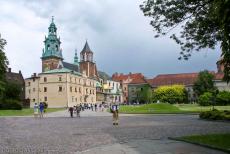
Historic Centre of Kraków: The Wawel Cathedral on Wawel Hill in Kraków. The Wawel Cathedral was the coronation site of the Polish monarchs. The crypt of the cathedral is the burial site of Polish kings. Karol Wojtyla, who became Pope John Paul II in 1978, said his first Mass as a priest in the 12th century crypt of the cathedral in 1946. The historic centre of Kraków is located at the foot of the Royal Castle on the Wawel hill. The Historic Centre of Kraków was inscribed on the UNESCO World Heritage List in 1978.
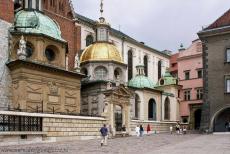
Historic Centre of Kraków: The gold-plated dome of the Kaplica Zygmuntowska, the Sigismund Chapel of the Wawel Cathedral. The Sigismund Chapel is one of the most notable examples of the Renaissance architecture in Poland. The chapel was designed by an Italian architect and was built between 1519 and 1533 for the Jagiełłonian dynasty. The royal chapel houses the tomb of his founder, King Sigismund I of Poland. The Wawel Cathedral has been extended and altered over the centuries, many burial chapels were built by the Polish rulers.
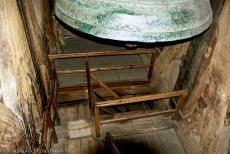
Historic Centre of Kraków: The dark stairway to the Sigismund Bell of Wawel Cathedral. Kraków was the capital city of Poland from 1038 to 1569. The current Wawel Cathedral was built in the 14th century. The Wawel Cathedral was the coronation and burial site of the Polish monarchs, even when Warsaw became the capital of Poland. The Royal Tombs of Polish Kings are situated in the side chapels and in the crypt. Father Karol Wojtyla, the later Pope John Paul II, said his first Mass as a priest in the St. Leonard's Crypt.
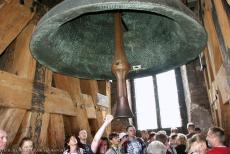
Historic Centre of Kraków: The Sigismund Bell of the Wawel Cathedral. It is possible to climb the Sigismund Tower of the Wawel Cathedral and to touch the clapper of the giant Sigismund Bell. The weight of the large clapper is 300 kg, it takes ten man to swing it. It is said that touching the clapper of the Sigismund Bell brings luck. The Sigismund Bell was named after King Sigismund I of Poland who commissioned it. There are another four bells in the Sigismund Tower, ranging in date from 1455 to 1751.
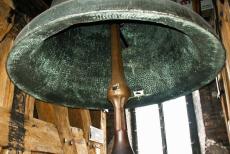
Historic Centre of Kraków: The giant Sigismund Bell of the Wawel Cathedral is heavier and 350 years older than the Big Ben in London. The Sigismund Bell weighs 9,650 kg, it was cast in 1520 from gun barrels. The bell is tolled only on Polish national holidays and major church occasions, it is said to be heard up to 50 km away, according to a popular folk wisdom the noise can drive the clouds away and bring sunshine. On April 8, 2005, while the funeral of the Polish-born Pope John Paul II was held in Rome, the Sigismund Bell, or Zygmunt Bell, was also tolled.
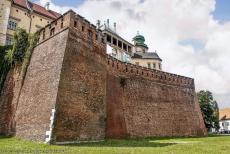
Historic Centre of Kraków: The Wawel Hill is located on the left bank of the Vistula River. The hill is a limestone outcropping, dominating the historic centre of Kraków. In 1037, Kraków became the capital city of Poland and the royal residence of Polish kings. The most important buildings on the Wawel Hill are the Wawel Cathedral and the Wawel Royal Castle. The Wawel Royal Castle, an armoury and the cathedral were built on the Wawel Hill in the 11th century. The Wawel Royal Castle is a mixture of Medieval, Romanesque, Renaissance and Baroque styles.
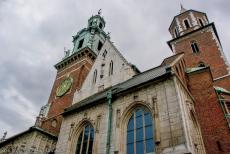
Historic Centre of Kraków: The towers of the Wawel Cathedral. The Wawel Cathedral has three towers, different in style and height. It is possible to climb the Sigismund Tower of the Wawel Cathedral. The tower holds the famous Sigismund Bell or Zygmunt Bell, the Dzwon Zygmunta. The Cathedral on Wawel Hill has a treasury, a library and a museum. The library is one of the oldest libraries in Poland. Polish kings were crowned and buried in the Cathedral on Wawel Hill.
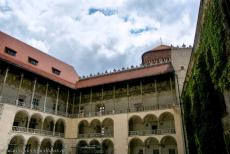
Historic Centre of Kraków: The Renaissance courtyard of the Wawel Royal Castle on the Wawel Hill. The 11th century Royal Castle was rebuilt in the 16th century. For many centuries, the castle was the official residence of the Polish Kings. The Wawel Royal Castle is now one of the premier art museums in Poland, it houses, for example, a large collection of paintings, among them work of Polish artists and masterpieces by the famous Dutch painter Rembrandt, the Crown Treasury houses memorabilia of Polish monarchs and the coronation sword Szczerbiec.
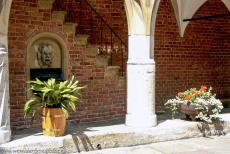
Historic Centre of Kraków: The Late-Gothic courtyard of the Collegium Maius of the Jagiełłonian University, the Collegium Maius is the oldest college of the university. The Jagiełłonian University is the oldest university in Poland, founded by King Władysław II Jagiełło in the 15th century. The Polish astronomer Nicolaus Copernicus studied at the Jagiełłonian University. The historic centre of Kraków, covering the Old Town and Wawel Hill, was inscribed on the UNESCO World Heritage List as Cracow's Historic Centre in 1978, name change in 2013 into: Historic Centre of Kraków.
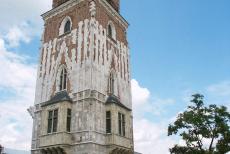
Historic Centre of Kraków: The 13th century Gothic Town Hall Tower. The tower once adjoined the Town Hall of Kraków, the town hall was demolished in 1820. The tower leans 55 cm, caused by a heavy storm in 1703. It is possible to climb the Town Hall Tower of Kraków, the top floor is open to visitors. The tower is 70 metres high, it is located in the Rynek Glówny, the main market square in the historic centre of Kraków, the Rynek Główny is one of the largest market squares in Europe.
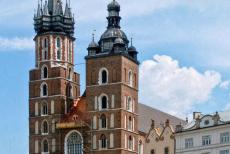
Historic Centre of Kraków: The 13th century Basilica of the Virgin Mary. The Basilica of the Virgin Mary is situated in the main Market Square Rynek Glówny in Kraków. The Basilica of the Virgin Mary is probably the most famous church in Poland. The lower tower is 69 metres high, it has a Renaissance roof and houses five bells. The tallest tower is 81 metres high, it has a Gothic spire and gold plated crown. The Kraków trumpet signal, the Hejnał Mariacki, is played by a trumpeter each hour from the highest tower of the basilica.
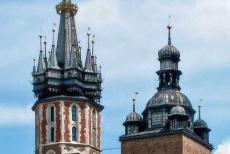
Historic Centre of Kraków: The Hejnał, the Kraków trumpet signal is played by a trumpeter each hour from the highest tower of the 13th century Basilica of the Virgin Mary. The Hejnał signal dates back to the Middle Ages. It was announcing the opening and closing of the city gates. The trumpeter also played it when he saw the enemy forces or a fire. Nowadays, the melody ends abruptly, to commemorate the 13th century trumpeter who was shot through his throat when he played the alarm before the Mongol attack on Kraków.
